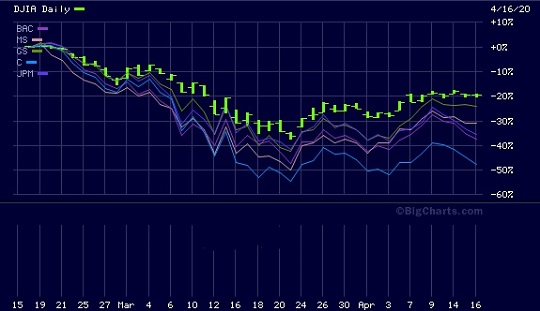Courtesy of Pam Martens
Bank Stocks’ Trading Pattern February 14 through April 16, 2020 versus Dow Jones Industrial Average. (BAC = Bank of America; MS = Morgan Stanley; GS = Goldman Sachs; C = Citigroup; JPM = JPMorgan Chase.)
By Pam Martens and Russ Martens
According to the Federal Deposit Insurance Corporation, as of yesterday there were 5,117 federally-insured banks and savings associations in the United States. But in terms of risk to the U.S. economy and financial system, according to the U.S. Treasury’s Office of Financial Research, only five of those banks matter. And as you can see from the chart above, those five banks are tanking.
On February 14 of this year, Citigroup’s share price closed at $78.79. Yesterday, it closed at $40.52, a decline of 48.5 percent in two months. This is the same bank that was resuscitated by its regulators during the 2007-2010 financial crash when its share price went to 99 cents. Citigroup received the largest bailout in global banking history, including $2.5 trillion in secret, cumulative revolving loans from the Federal Reserve.
On February 14, the common stock of JPMorgan Chase – the bank that has perpetually bragged for years about its “fortress balance sheet” — closed at 137.46. Yesterday JPMorgan Chase closed at $87.33, a decline of 36 percent in two months.
As the chart above indicates, the stock prices of the Wall Street mega banks are performing far worse than the broader market as measured by the Dow Jones Industrial Average (green line). That’s very bad news for the U.S. economy because it’s the industrial and energy and pharmaceutical and technology companies in the Dow that need to borrow from these banks in order to continue paying salaries to millions of workers and avoid severe layoffs. The financial condition of these banks essentially means the difference between the life and death of the U.S. economy. It’s not looking good so far.
…




